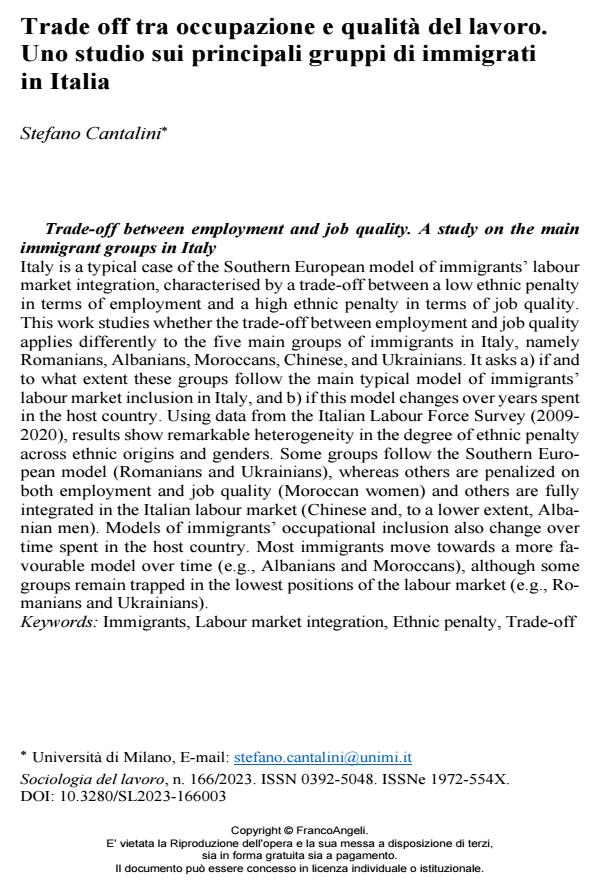Trade-off between employment and job quality. A study on the main immigrant groups in Italy
Journal title SOCIOLOGIA DEL LAVORO
Author/s Stefano Cantalini
Publishing Year 2023 Issue 2023/166
Language Italian Pages 25 P. 54-78 File size 326 KB
DOI 10.3280/SL2023-166003
DOI is like a bar code for intellectual property: to have more infomation
click here
Below, you can see the article first page
If you want to buy this article in PDF format, you can do it, following the instructions to buy download credits

FrancoAngeli is member of Publishers International Linking Association, Inc (PILA), a not-for-profit association which run the CrossRef service enabling links to and from online scholarly content.
Italy is a typical case of the Southern European model of immigrants’ labour market integration, characterised by a trade-off between a low ethnic penalty in terms of employment and a high ethnic penalty in terms of job quality. This work studies whether the trade-off between employment and job quality applies differently to the five main groups of immigrants in Italy, namely Romanians, Albanians, Moroccans, Chinese, and Ukrainians. It asks a) if and to what extent these groups follow the main typical model of immigrants’ labour market inclusion in Italy, and b) if this model changes over years spent in the host coun-try. Using data from the Italian Labour Force Survey (2009-2020), re-sults show remarkable heterogeneity in the degree of ethnic penalty across ethnic origins and genders. Some groups follow the Southern European model (Romanians and Ukrainians), whereas others are pe-nalized on both employment and job quality (Moroccan women) and others are fully integrated in the Italian labour market (Chinese and, to a lower extent, Albanian men). Models of immigrants’ occupational in-clusion also change over time spent in the host country. Most immi-grants move towards a more favourable model over time (e.g., Albani-ans and Moroccans), although some groups remain trapped in the low-est positions of the labour market (e.g., Romanians and Ukrainians).
Keywords: Immigrants, Labour market integration, Ethnic penalty, Trade-off
- Trovano un lavoro migliore da noi? La sovraqualificazione dei laureati rumeni in Italia Maria Giulia Montanari, in MONDI MIGRANTI 1/2025 pp.213
DOI: 10.3280/MM2025-001011
Stefano Cantalini, Trade off tra occupazione e qualità del lavoro. Uno studio sui principali gruppi di immigrati in Italia in "SOCIOLOGIA DEL LAVORO " 166/2023, pp 54-78, DOI: 10.3280/SL2023-166003